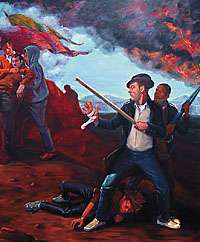 | School of Art graduate student Titus Kaphar is seen cutting out figures from his painting "New Revolution." |
Titus Kaphar, a graduate student at the School of Art, turned the Yale University Art Gallery into a personal studio of sorts while working on his M.F.A. thesis project.
In a kind of pre-digital life-size version of Photoshop™, Kaphar copies historical masterpieces or details from them, repopulates them with new portraits, often of himself, and then literally, with an Exacto™-knife, cuts out the figures he has created, and re-places them on a new blank canvas. Making this multi-stage art form even more complicated is the predilection of the artist to work directly in front of the original painting that inspired him.
On Dec. 5, Kaphar set up his 8' x 10' painting "New Revolution" in front of John Trumbull's panoramic depiction of "The Battle of Bunker Hill" (1786), which hangs in the Yale Art Gallery.
The original paintings that Kaphar chooses for his own works are among those few from the early period of American history to depict African Americans. Almost always the sole black person in a group portrait and other paintings of the 18th and 19th centuries is lower than the white people in the picture and off to a side, observes Kaphar, who has immersed himself in the study of the subject.
In "The Battle of Bunker Hill," for example, the densely populated composition includes one black figure peering over the shoulder of a tall white man in a dark hat.
By refiguring a visually marginalized black person in a historic painting into a portrait of himself or a contemporary and transposing the figure from the periphery of historic events to the center of a new canvas, Kaphar says, "I'm taking something pre-existing and reconstructing it. It's a way of revisiting history," he adds.
After cutting out the figures in his "New Revolution" while working at the gallery, Kaphar returned to his studio, where he will hand sew the removed figures onto a blank canvas of similar size. The cut painting and the reconfigured painting will be shown as a diptych throughout the life of the piece. Because the complex process is integral to the final work, Kaphar had it videotaped and that tape too will become part of the final installation.
T H I S
The art of cut-and-paste

Titus Kaphar's painting
"New Revolution" in its
original form.
"The visual marginalization of black people in painting reflects racial relationships and hierarchy historically in American society," he says.
 W E E K ' S
W E E K ' S S T O R I E S
S T O R I E S![]()
 Pepper stepping down as Yale V.P.
Pepper stepping down as Yale V.P.![]()
![]()
 INTERNATIONAL YALE
INTERNATIONAL YALE
 Trip strengthens Yale-Japan ties
Trip strengthens Yale-Japan ties![]()
 Fox Fellowship Program expands reach and focus
Fox Fellowship Program expands reach and focus![]()
 Initiative to develop new U.S.-India collaborations
Initiative to develop new U.S.-India collaborations![]()
![]()
 Student is embodiment of 'Life Transformed'
Student is embodiment of 'Life Transformed'![]()
![]()
 Matching contribution program for hurricane relief exceeds expectations
Matching contribution program for hurricane relief exceeds expectations![]()
![]()
 Campus events celebrate Martin Luther King Jr.
Campus events celebrate Martin Luther King Jr.![]()
![]()
 Images of sky reveal many large galaxies have merged
Images of sky reveal many large galaxies have merged![]()
![]()
 Scientists map complex cell signaling network
Scientists map complex cell signaling network![]()
![]()
 SCHOOL OF MEDICINE NEWS
SCHOOL OF MEDICINE NEWS
 NIF will serve as guide to online neuroscience resources
NIF will serve as guide to online neuroscience resources![]()
 New evidence supports a century-old theory . . .
New evidence supports a century-old theory . . .![]()
 Study reveals disparities between short- and long-term survival . . .
Study reveals disparities between short- and long-term survival . . .![]()
 Study finds link between HIV rates, incarceration
Study finds link between HIV rates, incarceration![]()
![]()
 New Law School website lists global provisions for protection of children
New Law School website lists global provisions for protection of children![]()
![]()
 Famous circus attraction is highlight of Peabody exhibit
Famous circus attraction is highlight of Peabody exhibit![]()
![]()
 The art of cut-and-paste
The art of cut-and-paste![]()
![]()
 YCIAS program to explore the theme 'Cuba from Within'
YCIAS program to explore the theme 'Cuba from Within'![]()
![]()
 Bromley tribute
Bromley tribute![]()
![]()
 Dean Speth's 'Red Sky at Morning' wins Connecticut Book Award
Dean Speth's 'Red Sky at Morning' wins Connecticut Book Award![]()
![]()
 Alexandrov wins MLA prize for his book about 'Anna Karenina'
Alexandrov wins MLA prize for his book about 'Anna Karenina'![]()
![]()
 In Memoriam: Dr. Charles F. McKhann
In Memoriam: Dr. Charles F. McKhann
![]()
![]()
 Japanese officials and Yale experts discuss programs . . .
Japanese officials and Yale experts discuss programs . . .![]()
![]()
 Campus Notes
Campus Notes![]()
![]()
 Security Procedures for Recess
Security Procedures for Recess![]()
Bulletin Home |
| Visiting on Campus
Visiting on Campus |
| Calendar of Events
Calendar of Events |
| In the News
In the News![]()
Bulletin Board |
| Classified Ads
Classified Ads |
| Search Archives
Search Archives |
| Deadlines
Deadlines![]()
Bulletin Staff |
| Public Affairs
Public Affairs |
| News Releases
News Releases |
| E-Mail Us
E-Mail Us |
| Yale Home
Yale Home